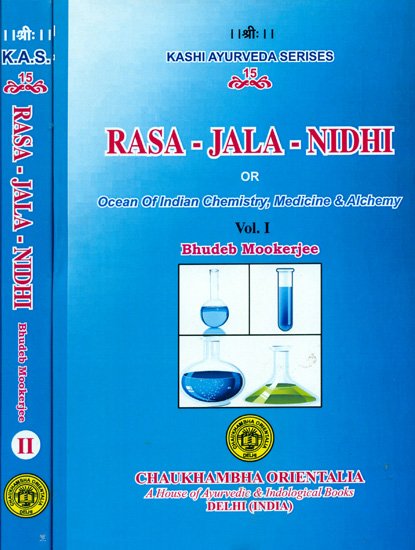Rasa Jala Nidhi, vol 3: Metals, Gems and other substances
by Bhudeb Mookerjee | 1938 | 47,185 words | ISBN-10: 8170305829 | ISBN-13: 9788170305828
This third volume of the Rasa-jala-nidhi deals with purification techniques of the Seven Metals (sapta-dhatu) and various Gems (ratna). It also deals with substances such as Alkalis (kshara), Salts (lavana), Poisions (visha) and Semi-poisions (upavisha) as well as various alcholic liquors. The Rasa-jala-nidhi (“the ocean of Iatrochemistry, or, che...
Part 21 - Treatment of poison
First process.
On the entrance of poison (visha) into a human system, the patient is to be made to vomit. He is to drink goat’s milk so long as he does not commence vomit-ting. Then he is to continue drinking the same milk after each act of vomiting, till the vomiting stops altogether. The strength of the poison is to be considered nullified as soon as the drinking of goat’s milk is followed no more by vomiting. In other words, no more milk is to be drunk by the patient when it is found that the last draft of milk is not vomited out.
Second process.
Poison, taken in an excessive quantity, should he remedied at once. The patient is first of all to be made to vomit till he vomits pitta (or bile). The vomit-ting is to be effected by means of drinking goat’s milk; or water mixed with powdered raji (rye seeds) and saindhava salt; or madana fruit pestled with water; or water with which fish has been washed off. After vomiting, the patient is to be purged till kapha or mucus comes out without stool. He is next to drink some cow’s ghrita (clarified butter), which is a destroyer of poison and giver of vitality.
Third process.
The following may be used for the purpose of destroying poison (a) drinking of the juices of turmeric tuber and meghanada (tanduliya); or (b) gandha-nakuli or tankana, mixed with clarified butter; or (c) kernel of the fruit of putranjiva, drunk with lemon juice, and the same pestled with water and used as a plaster upon the skin and as a collyrium for the eyes.
Fourth process.
The following group of vegetable drugs is a destroyer of poison:—jati (jessamine), nili (indigo plant), isvari-mula, saindhava(rock-salt), kaka-machi, apara-jita, triphala, karabira, kushtha, jasthi-madhu, jira, barks of kshira trees, (such as, asvattha, vata, etc.), and ela (cardamoms).
Cow’s butter (clarified) is also a destroyer of poison.
Fifth process.
If poison is taken in excess, cow’s ghrita (clarified butter), mixed with bhargi, dadhi (curd), vajrakshara (kshara prepared from snuhi plant), anantamula, tanduliya, soot (smoke condensed), manjista, and jastimadhu, should be swallowed by the patient.
Sixth process.
One who has taken poison in excess should take powdered bark of arjuna, mixed with honey and clarified butter; or he should take purified tankana mixed with honey and the juice of tanduliya roots.
Conclusion:
 This concludes ‘Treatment of poison’ included in Bhudeb Mookerjee Rasa Jala Nidhi, vol 3: Initiation, Mercury and Laboratory. The text includes treatments, recipes and remedies and is categorised as Rasa Shastra: an important branch of Ayurveda that specialises in medicinal/ herbal chemistry, alchemy and mineralogy, for the purpose of prolonging and preserving life.
This concludes ‘Treatment of poison’ included in Bhudeb Mookerjee Rasa Jala Nidhi, vol 3: Initiation, Mercury and Laboratory. The text includes treatments, recipes and remedies and is categorised as Rasa Shastra: an important branch of Ayurveda that specialises in medicinal/ herbal chemistry, alchemy and mineralogy, for the purpose of prolonging and preserving life.
